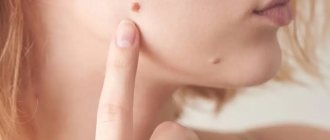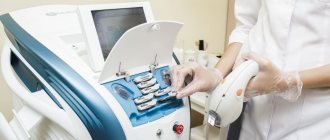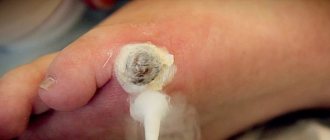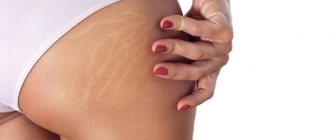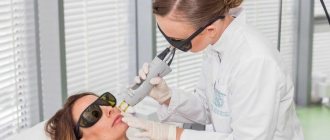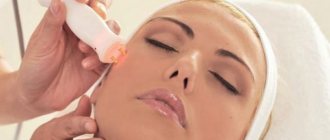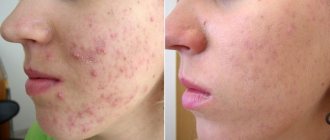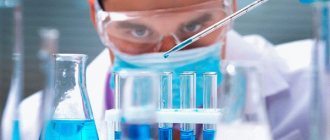Lipolysis - what is it?
This term refers to the process of breaking down fats into their acid components. Their breakdown is carried out under the action of lipase, an enzyme produced by the body. The basis of hardware lipolysis of adipose tissue is precisely this principle.
In this case, the breakdown of the fat layer and the removal of decay products from the body can be carried out using several methods. Depending on the chosen method, after exposure to the device, the structure of fat deposits is disrupted and they begin to collapse. After this, the melted fat enters the lymph and is eliminated from the body naturally.
To speed up the process of losing weight after the procedure, it is recommended to start playing sports and attend various physical procedures, as this will speed up the process of removing waste products.
Lipolysis - a new interpretation
Fat mobilization
Currently, after the discovery of adipose triglyceride lipase (ATGL, adipose triglyceride lipase, desnutrin ) in 2004, the previous concept of lipolysis has received a new interpretation. ATGL is responsible for the majority of lipolytic activity under both basal and stimulated conditions.
Under normal conditions, the surface of the lipid droplet contains the protein perilipin, ATGL and its coactivator called CGI-58 (comparative gene identification-58, or also Abhd5, abhydrolase domain-containing 5).
Hormone-sensitive lipase (HSL, hormone sensitive lipase) and fatty acid binding protein (FABP) are predominantly located in the cytoplasm .
In a quiescent adipocyte
- ATGL cleaves fatty acids (C16-C18) at the 2-position of triacylglycerol to form the product 1,3-DAG. Basal lipolysis occurs .
In a stimulated adipocyte
- perilipin , phosphorylated by protein kinase A, changes its conformation and moves away from the surface of the lipid droplet into the cytosol.
- CGI-58 protein separates from perilipin and attaches to ATGL, forming an active complex with it and changing its specificity.
- triglyceride lipase (ATGL), after binding to CGI-58, begins to cleave fatty acids from the 1st position of three acylglycerols, producing 2,3-DAG. It is 2,3-DAG that is a substrate of hormone-sensitive lipase (HSL).
- hormone-sensitive lipase (HSL) is phosphorylated by protein kinase A and/or protein kinase G and, in this active form, migrates to the lipid droplet. The absence of perilipin allows this lipase to approach the core of the lipid droplet, where it hydrolyzes 2,3 - diacylglycerols to 2-monoacylglycerols and free fatty acid.
- MAG lipase is located both in the cytosol and on the surface of the lipid droplet and hydrolyzes mono acylglycerols.
HSL's main substrate is diacylglycerols, it can also hydrolyze TAG and MAG, with a hydrolysis rate ratio of 20:2:1 for DAG:TAG:MAG, respectively.
Fatty acids leave the fat cell and bind to serum albumin and are transported by the bloodstream. They are then released from albumin and, with the help of tissue proteins that transport fatty acids , penetrate into target cells.
Regulation of lipolysis in adipocytes
The main role in lipolysis is played by the change in the state of perilipin under the influence of protein kinase A. Phosphorylation of hormone-sensitive lipase, although it increases its activity by 2-3 times, is nevertheless not able to ensure an increase in the total power of the process up to 50 times, which is observed with hormonal stimulation .
Substrate cycle
Basal breakdown and synthesis of triacylglycerols in adipose tissue are combined into a substrate cycle, which consists in the fact that 1,3-DAG, a product of low-active ATGL, is the preferred substrate of one of the enzymes of triacylglycerol synthesis, DAG acyl-transferase. As a result, ATGL and DAG-acyl-TP act in a coordinated manner and maintain a continuous TAG hydrolysis-reesterification
At rest, about 70% of fatty acids released with the participation of low-active ATGL do not leave the cell and are incorporated back into TAG. The remaining 30% of fatty acids are released into the blood. Fatty acids released into the blood are used in tissues, and some of them inevitably enter the liver , where they are re-esterified into TAG, and then their transport form VLDL . When the latter are metabolized, residual VLDL is formed in the blood plasma, some of which is converted into atherogenic LDL in the liver sinusoids. It is not difficult to imagine that the amount of VLDL and LDL formed directly depends on fat mass, which links obesity and the development of atherosclerosis.
Activation of the substrate fatty acid cycle is also facilitated by the often observed imbalance between the consumption of saturated and polyunsaturated fatty acids, since the lipid droplet in the adipocyte is surrounded by a monolayer of phospholipids , which should contain PUFAs. When the synthesis of phospholipids is disrupted, the access of ATGL lipase to triacylglycerols is facilitated and their hydrolysis is accelerated, and the proportion of saturated fatty acids released into the blood increases.
Excess of saturated fatty acids in the blood easily passes into cell membranes and lingers here, forming clusters. This changes the properties of the membrane, disrupts ion flows, and impairs the interaction of receptors with their ligands.
0
Varieties
When deciding to enroll in a lipolysis course, more than half of women are faced with the difficulty of choosing a technique. Each of the procedures is not only carried out in a different way, has its own advantages and disadvantages, but also differs in its effect on the body. In order to make the right choice and find the optimal solution, it is recommended to consult with a specialist who, after conducting a physiological examination, will tell you which method is more suitable for the client. Conventionally, lipolysis can be divided into 2 types:
- Invasive. The procedure is carried out using special injections for fat deposits.
- Non-invasive. With it, the fight against fat deposits is carried out in various ways that do not require injections or other intervention in the body.
Invasive lipolysis
If this method is chosen, the fight against fat will be carried out by introducing special preparations or vitamin cocktails into problem areas. Experts claim that this technique is more suitable for patients with a minimal amount of excess fat. The following are often used as active substances:
- Sodium deoxycholate. A substance of artificial origin, which is similar in structure to bile acid. Its production occurs only in the liver. This substance weakens the membrane of the capsules surrounding the fat cells, as a result of which fatty acids are released and enter the lymph, after which they are excreted from the body.
- Phosphatidylcholine. Increases the activity of organic compounds that destroy fats and prevents the formation of fibrous tissue.
- Organic silicon. Activates lipase, due to which the weight loss process accelerates several times.
- L-arginine. Increases the rate of fat breakdown and elimination from the body.
Lipolitics against cellulite are selected individually for each person, taking into account the characteristics of the body and the severity of the problem. Reviews about injections that break down fat deposits are mostly positive.
Important! Cosmetologists speak positively about injection lipolysis and claim that this is the only procedure that not only helps you lose weight, but also heals the skin as a whole.
Laser lipolysis
Laser removal of excess fat tissue is becoming increasingly popular. Modern equipment allows laser beams to be directed pointwise, making the breakdown of fatty tissue as efficient as possible. Products formed after decomposition are also eliminated as quickly as possible. Currently, laser lipolysis is the best alternative to surgical liposuction.
The procedure is carried out by inserting a probe through the skin, which produces laser radiation that melts fat cells. Since local anesthesia is given before the session, the woman will not experience any discomfort.
After the session is completed, the client is asked to stay in the clinic (for 1-2 hours) so that the doctors can observe the condition. If no complications arise, she is sent home. Rehabilitation after laser lipolysis is quite simple. The only restriction is that for the next 7 days the woman should not lift weights or play sports. The effect of the session will be noticeable in about 2-3 weeks.
Despite many advantages and effectiveness, laser lipolysis also has disadvantages:
- the procedure involves invasive intervention;
- there is a risk of minimal scars forming (they go away on their own after a few months);
- high price.
Ultrasonic lipolysis
Correction of figure contours is achieved by exposing the skin to ultrasonic waves, which are produced by a special sound transducer. After turning on the device, ultrasonic waves begin to penetrate the skin and increase the speed of movement of molecules, resulting in a massage effect.
All this leads to the fact that the enzymes contained in the cells are released and begin to fight fat deposits.
As practice shows, the positive result of the procedure appears quite quickly. Usually the first positive changes become noticeable after 3-5 sessions.
To achieve optimal results, it is recommended to complete a full course consisting of 12-15 sessions. It is recommended to carry out procedures at intervals of 2-3 days. The undoubted advantage of this non-invasive lipolysis technique is that the sessions are completely painless and do not cause physical discomfort. Other advantages include:
- lack of long-term rehabilitation;
- no traces of intervention remain on the skin after the procedure;
- fast and lasting results.
Radio wave
The technique is carried out by exposure to radio waves, which heat the tissue up to 45 degrees. This temperature causes tissue necrosis and disrupts the structure of fat cells under the epidermis. Since the waves only affect superficial areas, the subcutaneous tissue will not be damaged.
Radio wave lipolysis has a pronounced tightening effect and increases the elasticity of the skin. According to most cosmetologists, this procedure is more suitable for women with a thin layer of fat and mild cellulite.
Read whether fat returns after liposuction and how to deal with its consequences.
And here are the pros and cons of ultrasonic liposuction (cavitation).
Advantages
The positive effect of tissue and skin tightening is observed in patients after the first RF lipolysis procedure, and the desired result is achieved after 4–8 sessions.
The ReAction radiofrequency therapy device allows you to fully control the lipolysis process. Thanks to the effectiveness and safety of this technology, the radio wave RF lifting method is becoming very popular among clients of the best American and European clinics.
Achieving high levels of lifting and lipolysis efficiency
The RF lifting technique comes down to the effect of radio waves, tuned to three ranges, on subcutaneous fat tissue, skin and elastocollagen framework. These three radio waves of different frequencies contribute to the penetration of RF energy to different depths, having a tonic effect on the skin and fat layer.
Reviews
Women's opinions about the effectiveness of lipolysis differ. The number of negative and positive reviews is approximately the same. If you believe reviews on the Internet, the most effective are laser and injection lipolysis; after completing a course of such procedures, you can lose 2-4 kilograms.
But the final effect depends not only on which particular technique was used, but also on the initial weight and age of the patient. Young girls respond mostly positively to lipolysis injections. This is due to the fact that in a young body metabolic processes initially proceed faster, and therefore the process of losing weight is much easier.
Regardless of which particular technique was chosen, the result becomes noticeable no earlier than after 2 weeks. According to most women, lipolysis is not the main means of body correction, but an auxiliary one. If you approach the problem comprehensively, at the same time adjusting your diet and starting to exercise, the result will be impressive.
